
Aaadonta is a genus of air-breathing land snails, terrestrial pulmonate gastropod mollusks in the family Endodontidae. Specimens from this genus are endemic to Palau.
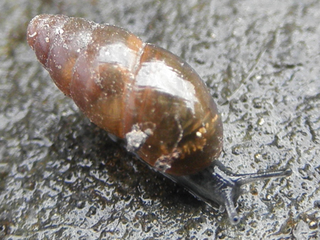
Cochlicopa, whose species are known as pillar snails, is a genus of small air-breathing land snails, terrestrial pulmonate gastropod mollusks in the family Cochlicopidae.

Elona quimperiana, common name the escargot de Quimper, is a species of air-breathing land snail, a terrestrial pulmonate gastropod mollusk in the family Elonidae.

Gonidomus is a genus of air-breathing land snails, terrestrial pulmonate gastropod mollusks in the subfamily Orthogibbinae of the family Streptaxidae.
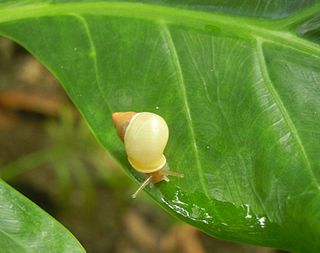
The fat Guam partula or humped tree snail, scientific name Partula gibba, is an endangered species of air-breathing land snail, a terrestrial gastropod mollusk in the family Partulidae.

Pyrenaearia carascalensis is a species of small air-breathing land snail, a terrestrial pulmonate gastropod mollusk in the family Hygromiidae, the hairy snails and their allies.
Zonitoides jaccetanicus is a species of small, air-breathing land snail, a terrestrial pulmonate gastropod mollusk in the family Gastrodontidae.

A land snail is any of the numerous species of snail that live on land, as opposed to the sea snails and freshwater snails. Land snail is the common name for terrestrial gastropod mollusks that have shells. However, it is not always easy to say which species are terrestrial, because some are more or less amphibious between land and fresh water, and others are relatively amphibious between land and salt water.

Bradybaena similaris, the Asian trampsnail, is a species of small, invasive land snail. It is a pulmonate gastropod terrestrial mollusc in the family Bradybaenidae. It earned the common name based on its origins, and its habit of roosting on freight containers. This habit means that this may be one of the most broadly-distributed species of terrestrial snail in the world. Bradybaena similaris is the type species of the genus Bradybaena.
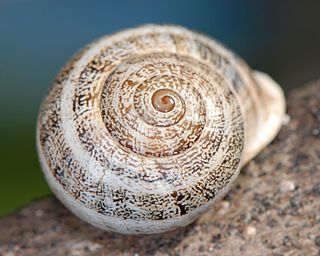
Otala lactea, known as the milk snail or Spanish snail, is a large, edible species of air-breathing land snail, a terrestrial pulmonate gastropod mollusk, in the family Helicidae, the typical snails.

Helicigona is a genus of medium-sized, air-breathing land snails, terrestrial pulmonate gastropod mollusks in the subfamily Ariantinae of the family Helicidae, the typical snails.
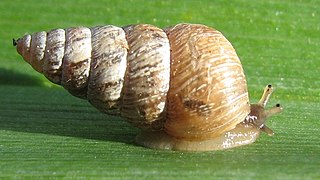
Cochlicella barbara, now known as Prietocella barbara, is a species of small but high-spired, air-breathing land snail, a pulmonate gastropod mollusk in the family Geomitridae.

Helicodonta, common name the "cheese snail", is a species of air-breathing land snail, a terrestrial pulmonate gastropod mollusk in the subfamily Helicodontinae of the family Helicodontidae.
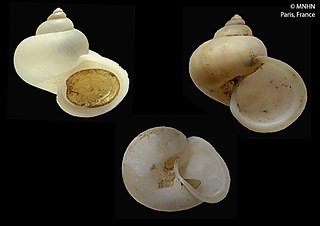
Leptopoma perlucidum is a species of land snail with a gill and an operculum, a terrestrial gastropod mollusk in the family Cyclophoridae.

Monacha obstructa is a species of air-breathing land snail, a terrestrial pulmonate gastropod mollusk in the family Hygromiidae, the hairy snails and their allies.

Corilla is a genus of air-breathing land snails, terrestrial pulmonate gastropod mollusks in the family Corillidae. This family has no subfamilies. It has been synonymised with Atopa Albers, 1850 and Helix (Corilla) Adams & Adams, 1855.

Dryocochlias metaformis is a species of medium-sized, air-breathing land snail, a terrestrial pulmonate gastropod mollusc in the family Camaenidae.
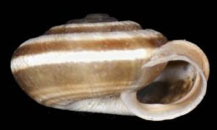
Zarateana arganica is a species of air-breathing land snail, a terrestrial pulmonate gastropod mollusk in the family Geomitridae.
Lapuz Lapuz Cave is cave in Bulabog Putian National Park in Moroboro, Dingle, Iloilo in the Philippines. It is 90 m (295.3 ft) long. The limestone area at its south end is adjacent to Jalaur River, while the north side is adjacent to the Tambunac River.

Hispaniolana is a genus of air-breathing land snails, terrestrial pulmonate gastropod mollusks in the subfamily Polydontinae of the family Sagdidae. The name comes from the island of Hispaniola, where all species are endemic to.



















